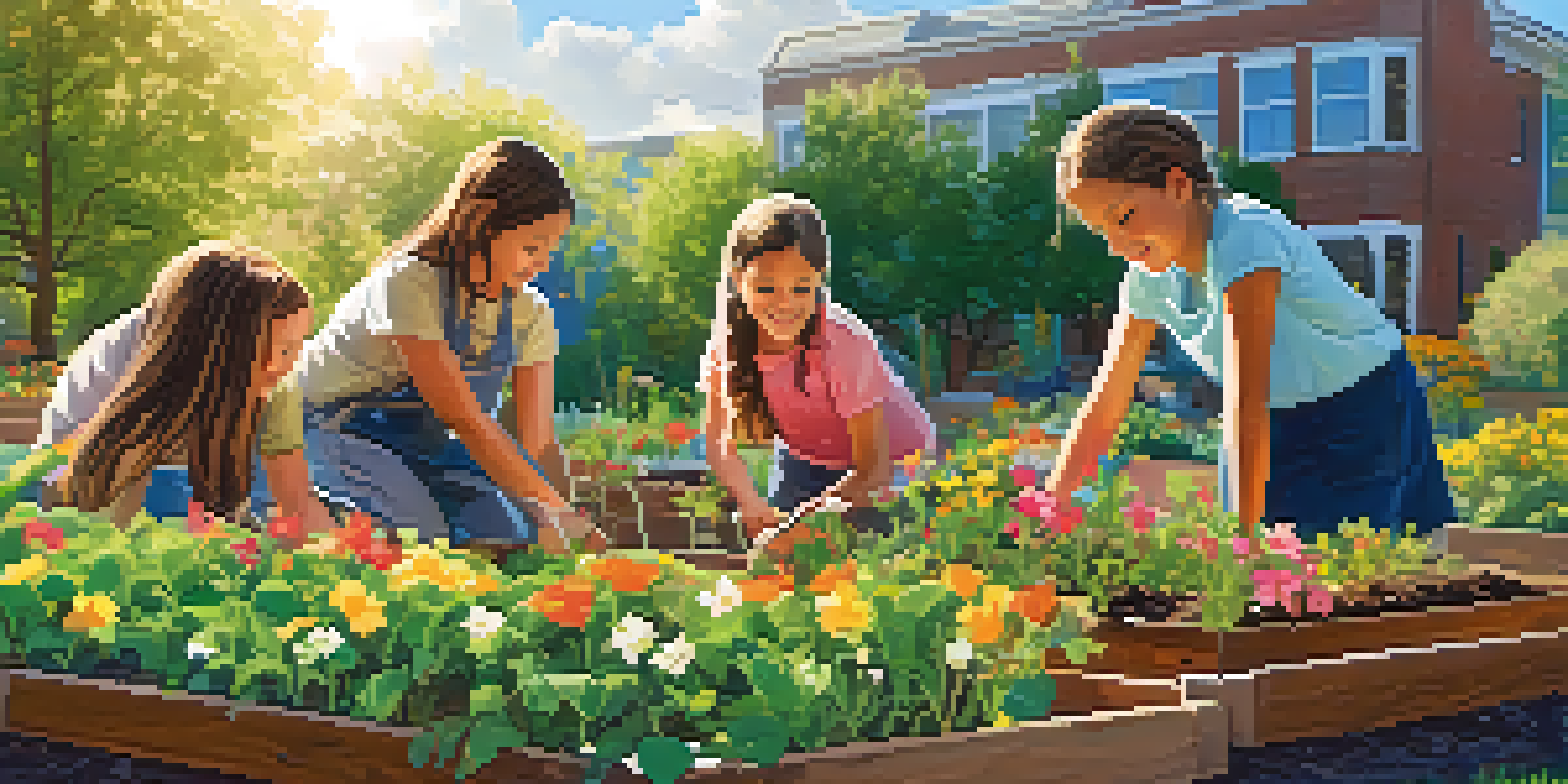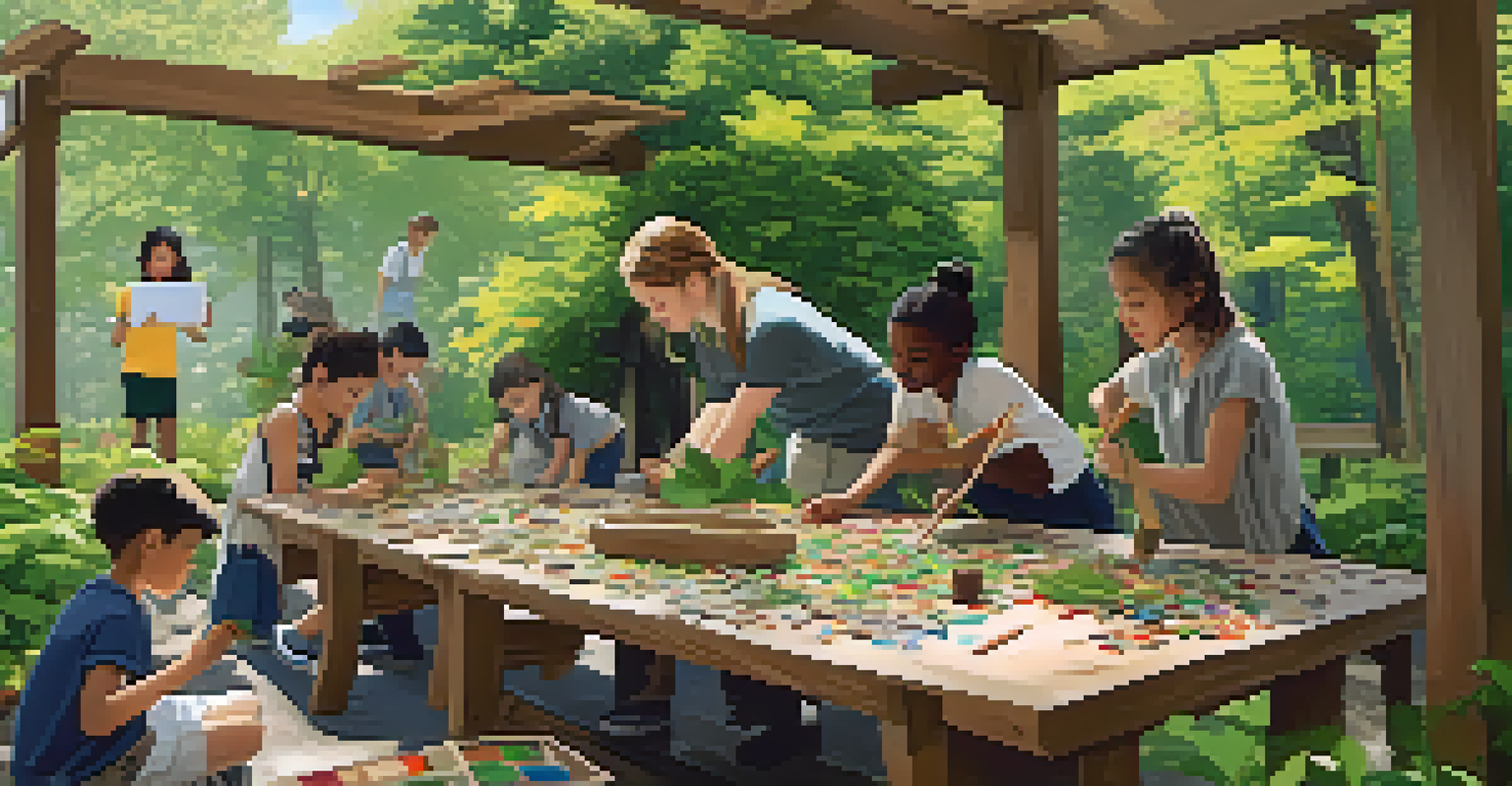The Impact of Outdoor Classrooms on Sustainability Learning

Understanding Outdoor Classrooms and Their Purpose
Outdoor classrooms are designated spaces where learning occurs outside traditional walls. These environments provide a unique opportunity for students to engage with nature while learning about various subjects, particularly sustainability. By immersing themselves in the natural world, students can develop a deeper appreciation for environmental issues.
The best way to predict the future is to create it.
The primary goal of outdoor classrooms is to make education more interactive and relevant. For instance, instead of reading about ecosystems from a textbook, students can observe them in real-time, fostering a hands-on learning experience. This experiential approach not only boosts engagement but also enhances knowledge retention.
Outdoor classrooms often involve activities such as gardening, nature walks, and wildlife observations. These experiences allow students to see firsthand the importance of biodiversity and the interconnections within ecosystems. Ultimately, this kind of learning promotes a sense of stewardship towards the environment.
The Role of Hands-On Learning in Sustainability Education
Hands-on learning is essential in teaching complex concepts like sustainability. When students participate in activities such as planting trees or recycling projects, they actively engage with the material, making the lessons more impactful. This approach encourages critical thinking and problem-solving skills, which are vital for addressing environmental challenges.

For example, a class might set up a compost bin to learn about waste reduction and soil health. This simple act can spark discussions about the broader implications of waste management in our communities. By connecting classroom lessons to real-world actions, students understand their role in fostering a sustainable future.
Hands-On Learning Boosts Engagement
Experiential activities in outdoor classrooms enhance student engagement and knowledge retention by connecting lessons to real-world experiences.
Moreover, hands-on learning nurtures a sense of responsibility. Students realize that their actions can lead to positive environmental outcomes, empowering them to make informed choices. This feeling of agency is crucial in developing future leaders who are committed to sustainability.
Benefits of Experiencing Nature for Students
Spending time in nature has numerous benefits for students, both mentally and physically. Research shows that outdoor activities can reduce stress, enhance mood, and improve focus. When students learn in an outdoor setting, they often feel more relaxed and open to exploring new ideas, which is particularly beneficial for complex topics like sustainability.
Education is the most powerful weapon which you can use to change the world.
Additionally, nature can inspire creativity. Surrounded by diverse flora and fauna, students may find new perspectives that spark innovative thinking. Whether it's brainstorming solutions to environmental problems or designing eco-friendly projects, the inspiration drawn from nature can lead to exciting educational outcomes.
Moreover, outdoor classrooms can foster social skills and teamwork. Many activities encourage collaboration, helping students build relationships and work effectively together. These interpersonal skills are essential not just in school but also in future careers, especially in fields focused on sustainability.
Fostering Environmental Stewardship Through Education
One of the primary aims of sustainability education is to foster environmental stewardship among students. Outdoor classrooms play a crucial role in this endeavor by instilling a sense of connection to the earth. When students engage with their surroundings, they often develop a desire to protect and preserve natural resources.
For instance, participating in local clean-up efforts can illustrate the impact of pollution on ecosystems. Such experiences can lead students to advocate for sustainable practices within their communities. These lessons about responsibility and care for the environment can last a lifetime, shaping their future actions and decisions.
Nature Supports Mental Health
Spending time in nature reduces stress and enhances focus, creating a relaxed environment that fosters creativity and innovative thinking.
Moreover, outdoor classrooms encourage students to become informed citizens. By exploring local environmental issues, students can better understand the importance of civic engagement. This awareness helps them recognize their role in shaping policies and practices that promote sustainability.
Integrating Outdoor Classrooms into School Curricula
Integrating outdoor classrooms into existing curricula requires careful planning and collaboration among educators. Schools can benefit from creating partnerships with local organizations that specialize in environmental education. These collaborations can provide resources, training, and support for teachers looking to implement outdoor learning experiences.
It's also essential to align outdoor activities with educational standards. By ensuring that lessons meet curriculum requirements, schools can demonstrate the value of outdoor classrooms to stakeholders, such as parents and school boards. This alignment can help build a case for continued investment in outdoor learning initiatives.
Finally, teachers can share successful outdoor classroom experiences with their colleagues. By cultivating a community of practice, educators can learn from one another and develop innovative approaches to teaching sustainability. This collaborative spirit can ultimately enhance the overall quality of education provided to students.
Overcoming Challenges in Outdoor Education
While outdoor classrooms offer many benefits, there are challenges to consider. Weather conditions, for example, can impact the ability to conduct outdoor lessons. Schools need to have contingency plans in place, such as providing alternative indoor activities that still align with sustainability themes.
Another challenge is ensuring that all students feel comfortable in outdoor environments. For some, the outdoors may present sensory challenges or fears. Educators should strive to create inclusive experiences that accommodate diverse needs, allowing every student to participate and benefit from outdoor learning.
Environmental Stewardship is Key
Outdoor classrooms instill a sense of responsibility and connection to nature, empowering students to advocate for sustainability in their communities.
Lastly, securing funding and resources for outdoor classrooms can be a hurdle. Schools may need to seek grants, sponsorships, or community support to develop and maintain these spaces. By demonstrating the positive impact of outdoor education on student learning, schools can make a compelling case for financial support.
The Future of Outdoor Classrooms and Sustainability Learning
As education continues to evolve, outdoor classrooms are becoming an increasingly popular tool for teaching sustainability. The growing awareness of environmental issues has prompted educators to seek innovative methods that resonate with students. Outdoor classrooms provide an effective way to engage students in critical conversations about their role in a sustainable future.
Looking ahead, we can expect to see more schools embracing outdoor education as a core part of their curriculum. This shift will likely involve not just traditional subjects but also interdisciplinary approaches that incorporate art, science, and social studies through outdoor activities. Such integration can provide a richer educational experience for students.

Ultimately, the future of outdoor classrooms lies in their ability to adapt and grow alongside educational needs. By continuing to foster a love for nature and a commitment to sustainability, these learning environments can play a pivotal role in shaping environmentally conscious citizens for generations to come.